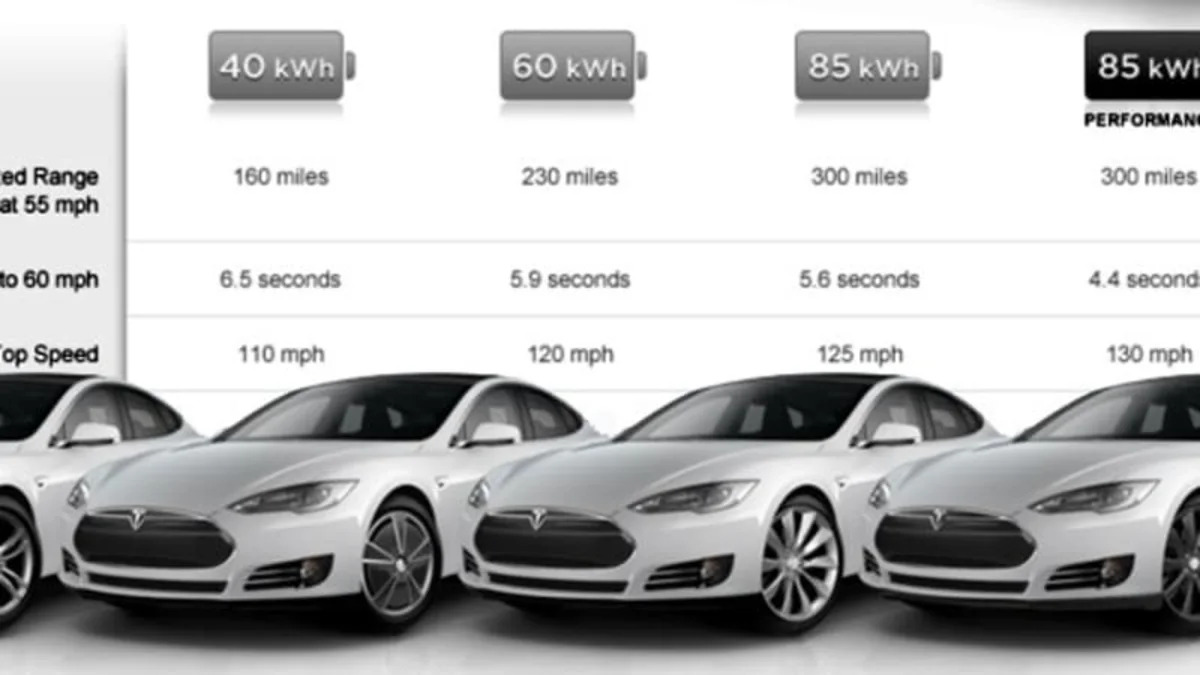When Tesla Motors revealed its pricing and specifications for its 2012 Model S, we couldn't help but notice an interesting peculiarity. The 0-to-60 times and top speeds varied according to pack size and, not only that, the variants with the larger, and presumably heavier, batteries were both quicker and faster. More oddness? The 40-kWh pack won't be able to take advantage of Tesla's yet-to-be-unveiled high-speed Supercharger network.
So, what gives? Well, it all seems to boil down to the batteries. Lithium ion batteries today suffer something of a tradeoff with energy capacity versus power – the ability to discharge (and recharge) that energy quickly. You can get cells that can either hold a large amount of energy but offer low discharge rates or you can get cells that hold lower amounts of energy but can discharge that energy quickly. Tesla uses the former type and that is how they are able to squeeze as much as 85 kWh worth of energy onto the Model S chassis.
However, the number of these cells tends to dictate performance. As Tesla tells us, "More cells, more power, quicker acceleration." While the larger 60- and 80-kWh packs have enough cells inside to collectively provide enough power to get the performance sedan up to 60 miles per hour in under six seconds, the 40-kWh pack comes up a bit short. Its 6.5 second time doesn't make it a slouch by any means but stepping up to the bigger batteries has its benefits.
Besides stop-light quickness, another advantage the larger packs offer is charging quickness. The 40 kWh Model S won't have an interface for Tesla's 90kW-Supercharger stations. While we might speculate that the reason for this decision is in part due to battery chemistry, the company will only say:
So, what gives? Well, it all seems to boil down to the batteries. Lithium ion batteries today suffer something of a tradeoff with energy capacity versus power – the ability to discharge (and recharge) that energy quickly. You can get cells that can either hold a large amount of energy but offer low discharge rates or you can get cells that hold lower amounts of energy but can discharge that energy quickly. Tesla uses the former type and that is how they are able to squeeze as much as 85 kWh worth of energy onto the Model S chassis.
However, the number of these cells tends to dictate performance. As Tesla tells us, "More cells, more power, quicker acceleration." While the larger 60- and 80-kWh packs have enough cells inside to collectively provide enough power to get the performance sedan up to 60 miles per hour in under six seconds, the 40-kWh pack comes up a bit short. Its 6.5 second time doesn't make it a slouch by any means but stepping up to the bigger batteries has its benefits.
Besides stop-light quickness, another advantage the larger packs offer is charging quickness. The 40 kWh Model S won't have an interface for Tesla's 90kW-Supercharger stations. While we might speculate that the reason for this decision is in part due to battery chemistry, the company will only say:
The shortcomings might not affect most Tesla S owners. According to an informal poll of buyers at Tesla Motors Club, more than 50 per cent plan on going whole hog with 85 kWhs while less than 16 per cent are settling for the least expensive option.Tesla offers different battery options for different types of drivers. Roadster owners, who have logged over 18 million real-world miles, have taught us that drivers have a variety of driving habits and needs. The three battery options are designed to give future Model S owners maximum choice to match their preferences.


Sign in to post
Please sign in to leave a comment.
Continue